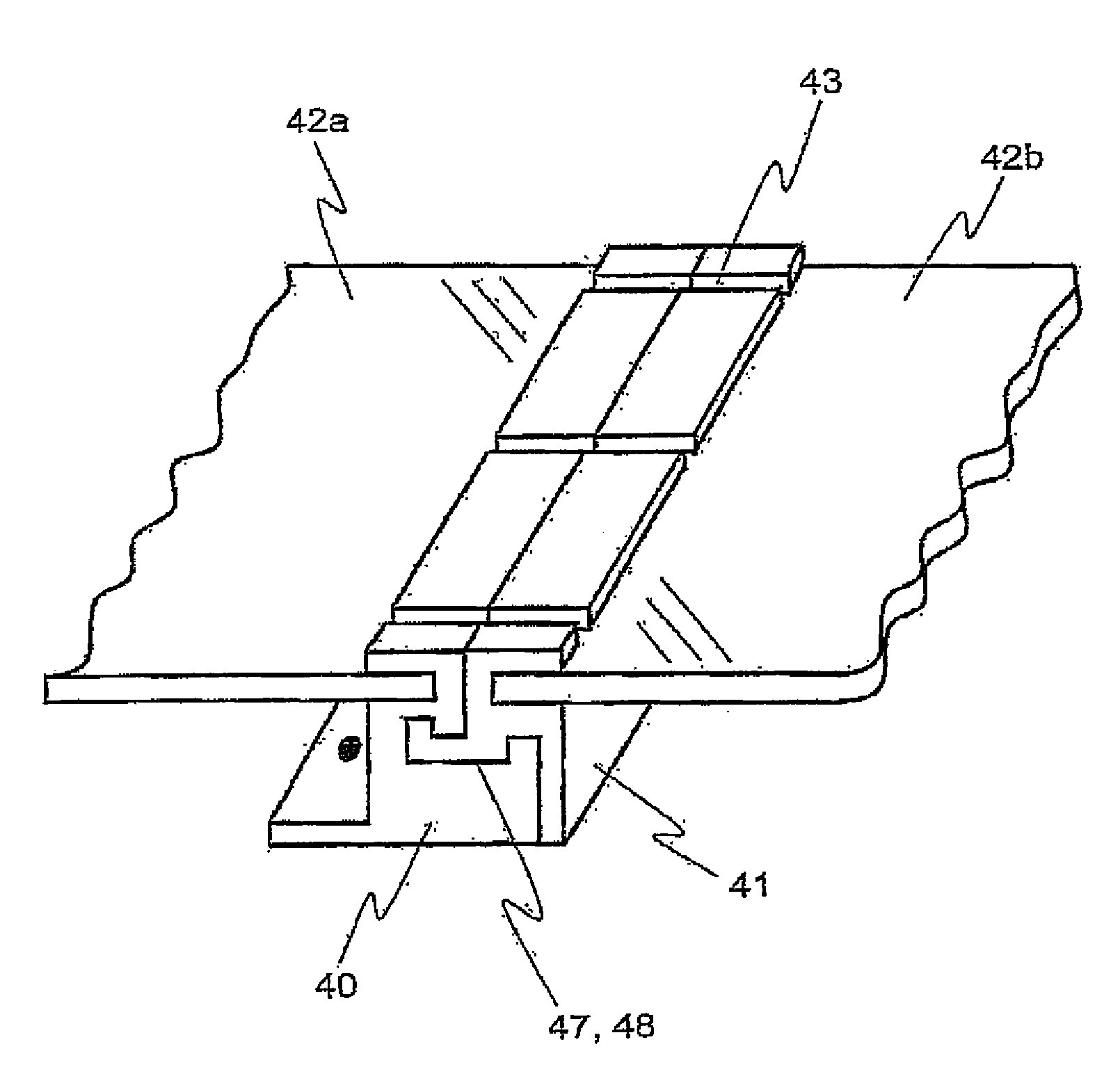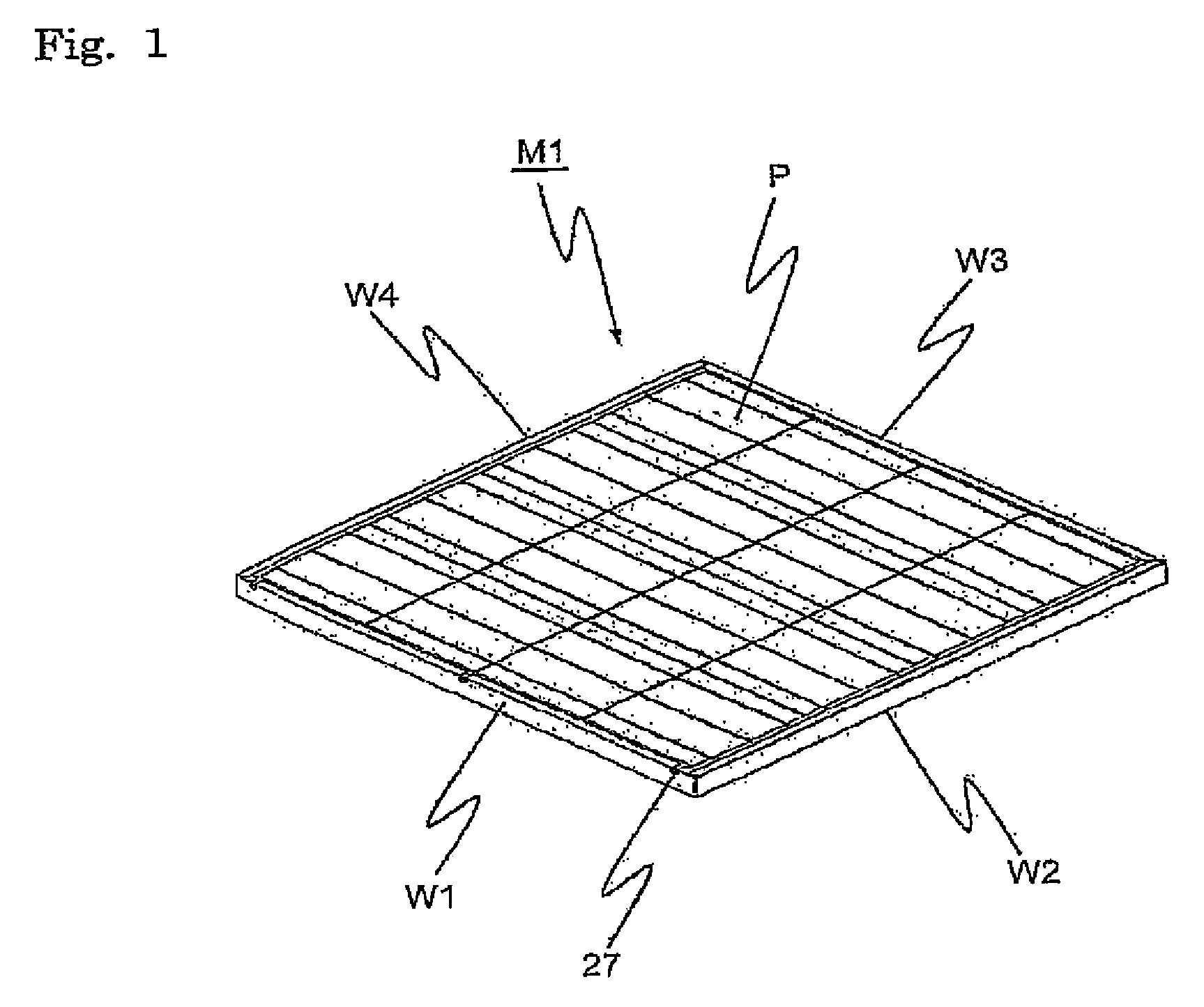Solar cell module and solar cell array
a solar cell and solar panel technology, applied in the direction of solar heat collector mounting/support, solar heat collector safety, light and heating apparatus, etc., can solve the problems of solar panel electrical output dramatically dropping, sunlight blocking, etc., to achieve sufficient hydrophilicity, improve disposability of liquid, and reduce power output
- Summary
- Abstract
- Description
- Claims
- Application Information
AI Technical Summary
Benefits of technology
Problems solved by technology
Method used
Image
Examples
first embodiment
[0095]FIG. 1 is an external perspective view of a solar cell module according to a first embodiment of the present invention.
[0096]A solar cell module M1 comprises solar cell panel P and four module frames W1 to W4 which are mounted to the external peripheral part of this solar cell panel P.
[0097]First, the solar cell panel P will be explained with reference to FIG. 2.
[0098]The solar cell panel P comprises a light receiving surface side member 1 that is a light-transmissive substrate, a light receiving surface side sealer 11, a solar cell element 2, a rear surface side sealer 13 and a rear surface side member 14 that is the rear surface sealer. Note that each solar cell element is electrically connected by a connection tab 3. Each structure will be explained in detail below.
[0099]A substrate that is comprised of a glass or a polycarbonate resin is used for the light receiving surface side member 1. Examples of the glass may be a white plate glass, tempered glass, double-tempered gla...
second embodiment
[0146]A solar cell module according to a second embodiment of the present invention will be explained with reference to FIGS. 11 to 19. Note that the same configurations as those of the first embodiment are assigned the same reference numerals and the explanation therefor is omitted. Characteristic parts of the present embodiment will mainly be explained below.
[0147]FIG. 11 is an external perspective view of a solar cell module M2 according to a second embodiment of the present invention.
[0148]A plurality of the notches 27 similar to that in the aforementioned embodiment are provided to a module frame W5 of the solar cell module M2 at its both ends and at the center. By providing a notch group 33 comprising a plurality of notches 27 at the both ends and the center of the module frame W5, the liquid during or after rain can be smoothly discharged even for a large-sized solar cell module such as the solar cell module M1 with each side exceeding 70 cm, thus dirt is less likely to remai...
third embodiment
[0158]A solar cell module according to the third embodiment of the present invention will be explained with reference to FIGS. 20 to 25.
[0159]The present embodiment is characterized in that a protruding portion is provided on at least a part of the exterior side surface of the module frame such there is a predetermined gap between the solar cell module, and another member and the adjacent solar cell module. Note that the same configurations as those of the first embodiment are assigned the same reference numerals and the explanation therefor is omitted. The module frame W1 to which the protruding portion is formed will mainly be explained below.
[0160]FIG. 20 is an external perspective view of a module frame W1, among the module frames mounted to the external peripheral of the solar cell panel P, that is mounted to the side that comes to the lower side of the inclined direction of the solar cell module when the solar cell module is set tilted. FIG. 21 is its partial enlarged perspect...
PUM
 Login to View More
Login to View More Abstract
Description
Claims
Application Information
 Login to View More
Login to View More - R&D
- Intellectual Property
- Life Sciences
- Materials
- Tech Scout
- Unparalleled Data Quality
- Higher Quality Content
- 60% Fewer Hallucinations
Browse by: Latest US Patents, China's latest patents, Technical Efficacy Thesaurus, Application Domain, Technology Topic, Popular Technical Reports.
© 2025 PatSnap. All rights reserved.Legal|Privacy policy|Modern Slavery Act Transparency Statement|Sitemap|About US| Contact US: help@patsnap.com



